The global cable line fault indicator market is valued at USD 231.8 million in 2025 and is set to reach USD 314.6 million by 2035, growing at a CAGR of 3.1%. Regulatory and environmental considerations strongly influence adoption and deployment. Government mandates, international standards, and utility-specific compliance frameworks define how fault indicators are designed, tested, and integrated into grid infrastructure. Environmental conditions such as extreme temperatures, moisture, and mechanical stress further shape innovation and product reliability.
Government mandates on grid monitoring and reliability standards play a defining role. Utilities are required to improve uptime, reduce outage durations, and provide higher levels of service continuity. Regulators impose penalties for prolonged downtime and incentivize investments in grid modernization. Fault indicators, both overhead and underground, support compliance by enabling faster detection and localization of faults. Deployment of such devices aligns with broader objectives of power reliability, rural electrification, and reduced transmission losses. Utility regulators in North America and Europe demand advanced monitoring capabilities in distribution networks, while emerging economies link mandates to infrastructure expansion and rural grid stability.
Incentives for smart grid and digital substation deployment enhance the cable line fault indicatormarket outlook. National and regional programs provide financial support for grid automation projects, including fault detection technologies. Fault indicators integrated with IoT sensors and communication modules contribute to real-time monitoring and predictive analytics. Governments promote digital substations as part of energy transition strategies, enabling renewable energy integration and improved fault tolerance. Subsidies, grants, and concessional financing options encourage utilities to accelerate adoption of intelligent indicators within grid modernization frameworks. These incentives drive both initial deployment and replacement of outdated monitoring devices.
Compliance with IEC, IEEE, and local utility standards remains non-negotiable. Manufacturers must design fault indicators that adhere to international performance benchmarks covering accuracy, durability, safety, and interoperability. IEC standards outline parameters for electrical endurance and measurement reliability. IEEE guidelines provide protocols for integration with SCADA and advanced distribution management systems. Local utility standards set additional conditions for installation, communication protocols, and testing procedures. Failure to meet compliance requirements delays approvals and limits adoption. Certification processes thus shape product development cycles, supply chain efficiency, and market competitiveness.
Environmental considerations add another dimension. Fault indicators are exposed to demanding conditions including extreme heat, freezing temperatures, humidity, salt exposure in coastal regions, and mechanical stress in underground installations. Ruggedized designs with sealed enclosures, corrosion-resistant materials, and extended temperature tolerances are developed to meet environmental challenges. Indicators must remain reliable during storms, floods, and seismic activity, ensuring resilience in disaster-prone regions. Energy efficiency and long service lifetimes further reduce the environmental footprint.
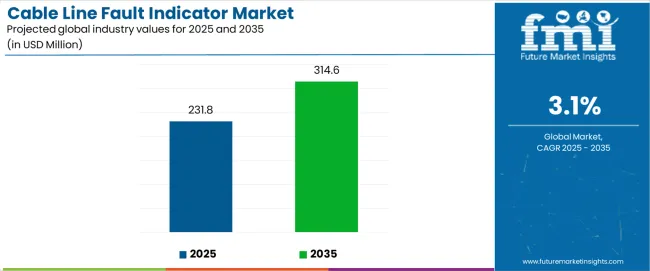
The cable line fault indicator market demonstrates distinct growth phases with varying market characteristics and competitive dynamics. Between 2025 and 2030, the cable line fault indicator market progresses through its smart grid integration phase, expanding from USD 231.8 million to USD 271.2 million with steady annual increments averaging 3.2% growth. This period showcases the transition from basic fault detection devices to advanced IoT-enabled systems with enhanced communication capabilities and integrated diagnostic features becoming mainstream components.
The 2025-2030 phase adds USD 39.4 million to market value, representing 47% of total decade expansion. Market maturation factors include standardization of communication protocols, declining costs for smart monitoring devices, and increasing utility awareness of automated fault detection benefits reaching 80-85% effectiveness in grid reliability applications. Competitive landscape evolution during this period features established manufacturers like TE Connectivity and Schneider Electric expanding their product portfolios while new entrants focus on specialized wireless solutions and enhanced predictive analytics technology.
From 2030 to 2035, market dynamics shift toward comprehensive grid modernization and multi-utility deployment, with growth accelerating from USD 271.2 million to USD 314.6 million, adding USD 43.4 million or 53% of total expansion. This phase transition logic centers on universal smart monitoring systems, integration with automated grid management platforms, and deployment across diverse utility scenarios, becoming standard rather than specialized monitoring formats. The competitive environment matures with focus shifting from basic fault detection to comprehensive grid intelligence and compatibility with modern distribution automation systems.
| Metric | Value |
|---|---|
| $ Market Value (2025) | USD 231.8 million |
| $ Market Forecast (2035) | USD 314.6 million |
| # Growth Rate | 3.10% CAGR |
| Leading Type | Automatic Reset |
| Primary Application | Commercial Segment |
The cable line fault indicator market demonstrates strong fundamentals with Automatic Reset systems capturing a dominant share through superior operational reliability and cost-effective maintenance capabilities. Commercial applications drive primary demand, supported by increasing industrial infrastructure requirements and enhanced grid monitoring solutions. Geographic expansion remains concentrated in developed markets with established electrical infrastructure, while emerging economies show accelerating adoption rates driven by grid modernization projects and rising power reliability requirements.
The cable line fault indicator market represents a compelling intersection of power system monitoring innovation, IoT technology advancement, and grid reliability optimization management. With robust growth projected from USD 231.8 million in 2025 to USD 314.6 million by 2035 at a 3.10% CAGR, this market is driven by increasing grid modernization trends, utility infrastructure requirements, and industrial demand for reliable fault detection formats.
The cable line fault indicator market's expansion reflects a fundamental shift in how utilities and industrial facilities approach power distribution monitoring. Strong growth opportunities exist across diverse applications, from commercial operations requiring automated fault detection to utility networks demanding comprehensive monitoring solutions. Geographic expansion is particularly pronounced in Asia-Pacific markets, led by China (4.2% CAGR) and India (3.9% CAGR), while established markets in North America and Europe drive innovation and specialized segment development.
The dominance of Automatic Reset systems and commercial applications underscores the importance of proven monitoring technology and operational reliability in driving adoption. Communication protocols and integration complexity remain key challenges, creating opportunities for companies that can deliver consistent performance while maintaining cost efficiency.
Market expansion rests on three fundamental shifts driving adoption across utility and industrial sectors. Grid modernization creates compelling advantages through fault indicator systems that provide comprehensive monitoring with automated detection capabilities, enabling utilities to manage increasing power demands and maintain reliability standards while ensuring efficient fault location operations and justifying investment over traditional inspection methods. Industrial facility automation accelerates as manufacturers worldwide seek reliable monitoring systems that deliver operational efficiency directly to production operations, enabling downtime reduction that aligns with facility management expectations and maximizes power system productivity. Power infrastructure aging drives adoption from utility operators requiring proactive maintenance solutions that maximize system reliability while maintaining cost-effective performance during fault detection and isolation operations.
The growth faces headwinds from equipment cost considerations that differ across utility budgets regarding capital expenditure allocation and return on investment timelines, potentially limiting deployment frequency in price-sensitive utility categories. Communication infrastructure requirements also persist regarding network compatibility and data management protocols that may increase complexity standards in markets with demanding grid integration requirements.
Primary Classification: The cable line fault indicator market segments by type into Automatic Reset, Manual Reset, and Others categories, representing the evolution from basic fault detection devices to advanced automated systems for comprehensive power monitoring operations.
Secondary Breakdown: Application segmentation divides the cable line fault indicator market into Commercial, Residential, Industrial, Utility, and Transportation sectors, reflecting distinct requirements for monitoring capabilities, communication protocols, and environmental resistance.
Tertiary Classification: Technology segmentation includes Overhead Line Indicators, Underground Cable Indicators, Panel Mount Indicators, and Portable Testing Units, addressing diverse installation requirements and monitoring scenarios.
Regional Classification: Geographic distribution covers Asia Pacific, North America, Europe, Latin America, and the Middle East & Africa, with developed markets leading technology adoption while emerging economies show accelerating growth patterns driven by infrastructure development programs.
The segmentation structure reveals technology progression from standard fault detection toward integrated smart monitoring platforms with enhanced communication and diagnostic capabilities, while application diversity spans from residential operations to utility networks requiring comprehensive fault management and real-time monitoring solutions.
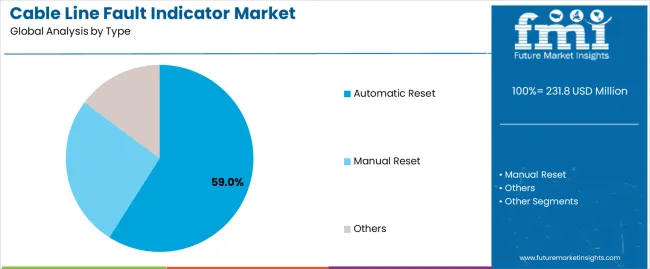
Automatic reset segment is estimated to account for 59% of the cable line fault indicator market share in 2025. The segment's leading position stems from its fundamental role as a critical component in automated fault detection applications and its extensive use across multiple commercial and utility sectors. Automatic Reset's dominance is attributed to its superior operational efficiency, including reduced maintenance requirements, reliable reset functionality, and enhanced cost-effectiveness that make it indispensable for modern power monitoring operations.
Market Position: Automatic Reset systems command the leading position in the cable line fault indicator market through advanced electronic technologies, including comprehensive fault detection algorithms, automatic diagnostic capabilities, and reliable communication performance that enable operators to deploy monitoring solutions across diverse electrical environments.
Value Drivers: The segment benefits from utility preference for proven automated profiles that provide exceptional reliability without requiring frequent manual intervention. Efficient operation processes enable deployment in commercial facilities, utility networks, and industrial applications where operational reliability and cost efficiency represent critical selection requirements.
Competitive Advantages: Automatic Reset systems differentiate through excellent fault detection accuracy, proven communication reliability, and compatibility with standard monitoring equipment that enhance grid management capabilities while maintaining economical operational profiles suitable for diverse power system applications.
Key market characteristics:
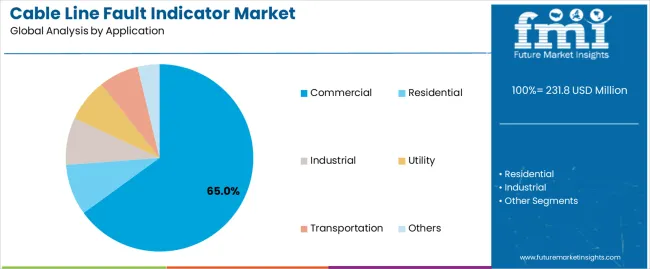
Commercial segment is projected to hold 65% of the cable line fault indicator market share in 2025. The segment's market leadership is driven by the extensive use of fault indicators in commercial buildings, office complexes, shopping centers, and business facilities, where monitoring devices serve as both a safety system and operational efficiency solution. The commercial sector's consistent demand for reliable fault detection supports the segment's dominant position.
Market Context: Commercial applications dominate the cable line fault indicator market due to widespread adoption of automated monitoring solutions and increasing focus on electrical safety, power reliability, and operational continuity that enhance business operations while maintaining safety standards.
Appeal Factors: Commercial facility operators prioritize system reliability, automated alerts, and integration with building management systems that enable coordinated deployment across multiple electrical circuits. The segment benefits from substantial commercial development and infrastructure modernization that emphasize reliable monitoring systems for business-critical applications.
Growth Drivers: Building automation programs incorporate fault indicators as standard components for electrical monitoring and safety systems. At the same time, facility management initiatives are increasing demand for advanced features that comply with safety standards and enhance operational visibility.
Market Challenges: Equipment cost considerations and installation complexity may limit deployment flexibility in cost-sensitive commercial markets or buildings with varying electrical system requirements.
Application dynamics include:
Growth Accelerators: Grid modernization drives primary adoption as fault indicator systems provide exceptional monitoring capabilities that enable power management without system interruption, supporting reliability improvement and utility efficiency that require dependable monitoring formats. Infrastructure aging accelerates market expansion as utilities seek proactive maintenance solutions that maintain system reliability during operation while enhancing fault location convenience through automated detection and improved operational efficiency. Technology advancement increases worldwide, creating sustained demand for intelligent monitoring systems that complement grid operations and provide operational advantages in power system management efficiency.
Growth Inhibitors: Equipment cost challenges differ across utility budgets regarding capital expenditure planning and investment return timelines, which may limit deployment frequency and cost planning in budget-constrained utility categories with demanding affordability requirements. Installation complexity persists regarding system integration and communication protocol compatibility that may increase implementation costs in facilities with existing power monitoring infrastructure. Market fragmentation across multiple communication standards and protocol specifications creates compatibility concerns between different monitoring systems and existing electrical infrastructure.
Market Evolution Patterns: Adoption accelerates in commercial and utility sectors where reliability benefits justify technology investments, with geographic concentration in developed markets transitioning toward mainstream adoption in emerging economies driven by grid modernization and infrastructure development. Technology advancement focuses on enhanced communication capabilities, improved diagnostic features, and integration with comprehensive grid management systems that optimize monitoring performance and operational consistency. The cable line fault indicator market could face disruption if alternative monitoring methods or communication technologies significantly challenge traditional fault indicator advantages in power system applications.
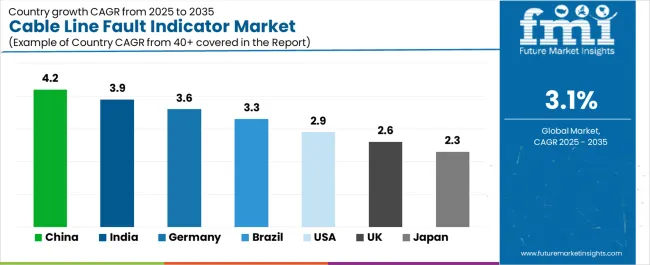
The cable line fault indicator market demonstrates varied regional dynamics with growth leaders including China (4.2% CAGR) and India (3.9% CAGR) driving expansion through infrastructure modernization and grid development programs. Steady Performers encompass Germany (3.6% CAGR), Brazil (3.3% CAGR), and the U.S. (2.9% CAGR), benefiting from established electrical infrastructure and technology adoption initiatives.
| Country | CAGR (2025-2035) |
|---|---|
| China | 4.2% |
| India | 3.9% |
| Germany | 3.6% |
| Brazil | 3.3% |
| USA | 2.9% |
| UK | 2.6% |
| Japan | 2.3% |
Regional synthesis reveals Asia-Pacific markets leading growth through infrastructure expansion and grid modernization development, while European countries maintain steady expansion supported by technology advancement and grid reliability requirements. North American markets show moderate growth driven by utility modernization and commercial facility upgrades.
China establishes regional leadership through massive grid expansion and comprehensive power infrastructure modernization, integrating advanced fault indicator systems as standard components in transmission networks and industrial facility monitoring operations. The country's 4.2% CAGR through 2035 reflects urbanization growth promoting industrial density and electrical infrastructure development that mandate the use of reliable monitoring systems in power distribution operations.
Strategic Market Indicators:
The Indian market emphasizes power reliability applications, including rapid infrastructure development and comprehensive grid expansion that increasingly incorporates fault indicators for transmission monitoring and industrial facility applications. The country is projected to show a 3.9% CAGR through 2035, driven by massive electrification activity under rural development initiatives and utility demand for standardized, high-quality monitoring systems. Indian power facilities prioritize cost-effectiveness with fault indicators delivering operational efficiency through economical technology usage and reliable performance capabilities.
Technology deployment channels include major utilities, industrial facilities, and infrastructure developers that support high-volume usage for domestic and commercial applications.
Performance Metrics:
The German market emphasizes advanced fault indicator features, including innovative communication technologies and integration with comprehensive grid management platforms that manage transmission monitoring, industrial operations, and renewable energy applications through unified monitoring systems. The country is projected to show a 3.6% CAGR through 2035, driven by grid modernization under renewable energy transition trends and utility demand for premium, reliable monitoring systems. German utilities prioritize precision with fault indicators delivering comprehensive power management through enhanced diagnostic capabilities and operational innovation.
Technology deployment channels include major utilities, industrial operators, and renewable energy developers that support custom development for premium operations.
Performance Metrics:
In São Paulo, Rio de Janeiro, and Belo Horizonte, Brazilian utilities and industrial operators are implementing advanced fault indicator systems to enhance grid capabilities and support operational efficiency that aligns with infrastructure development protocols and reliability standards. The Brazilian market demonstrates sustained growth with a 3.3% CAGR through 2035, driven by infrastructure modernization programs and utility investments that emphasize reliable monitoring systems for transmission and industrial applications. Brazilian power facilities are prioritizing fault indicator systems that provide exceptional reliability while maintaining compatibility with existing electrical infrastructure and minimizing operational complexity, particularly important in utility networks and industrial facility operations.
Market expansion benefits from government programs that mandate enhanced monitoring in power specifications, creating sustained demand across Brazil's utility and industrial sectors, where reliability and system consistency represent critical requirements.
Strategic Market Indicators:
The U.S. market emphasizes comprehensive fault indicator deployment, growing at 2.9% CAGR, with documented operational excellence in utility networks and industrial applications through integration with existing grid management systems and reliability assurance infrastructure. The country leverages engineering expertise in power electronics and communication technology to maintain market leadership. Utility centers, including California, Texas, and New York, showcase advanced installations where fault indicator systems integrate with comprehensive grid platforms and automation systems to optimize power management and operational efficiency.
American utilities prioritize monitoring precision and communication reliability in technology selection, creating demand for advanced fault indicator systems with premium features, including wireless connectivity and integration with automated grid protocols. The cable line fault indicator market benefits from established electrical infrastructure and willingness to invest in specialized monitoring technologies that provide superior diagnostic capabilities and regulatory compliance.
Market Intelligence Brief:
The U.K. market demonstrates sophisticated fault indicator deployment, growing at 2.6% CAGR, with emphasis on grid modernization and renewable energy integration through comprehensive monitoring solutions and reliability enhancement programs. British utilities prioritize system integration and communication excellence, creating demand for advanced fault indicator systems with enhanced diagnostic capabilities and weather resistance features suitable for diverse electrical environments.
Market expansion focuses on utility networks and industrial facilities where fault indicators provide operational efficiency and regulatory compliance benefits, with particular emphasis on renewable energy integration and grid stability requirements that mandate reliable monitoring solutions.
Performance Metrics:
Japan's sophisticated power management market demonstrates meticulous fault indicator deployment, growing at 2.3% CAGR, with documented operational excellence in utility networks and industrial applications through integration with existing grid monitoring systems and quality assurance infrastructure. The country leverages engineering expertise in electronics manufacturing and precision technology to maintain market leadership. Industrial centers, including Tokyo, Osaka, and Nagoya, showcase advanced installations where fault indicator systems integrate with comprehensive power platforms and automation systems to optimize grid management and operational efficiency.
Japanese utilities prioritize monitoring precision and system reliability in product selection, creating demand for premium fault indicator systems with advanced features, including precision diagnostics and integration with automated grid protocols. The cable line fault indicator market benefits from established power infrastructure and willingness to invest in specialized monitoring technologies that provide superior performance capabilities and regulatory compliance.
Market Intelligence Brief:
The cable line fault indicator market in Europe is projected to grow from USD 52.4 million in 2025 to USD 74.8 million by 2035, registering a CAGR of 3.6% over the forecast period. Germany is expected to maintain its leadership position with a 42.1% market share in 2025, declining slightly to 41.8% by 2035, supported by its grid modernization excellence and major utility centers, including North Rhine-Westphalia and Bavaria.
United Kingdom follows with a 28.3% share in 2025, projected to reach 28.7% by 2035, driven by comprehensive grid reliability programs and industrial facility initiatives. France holds a 16.2% share in 2025, expected to maintain 16.4% by 2035 through established utility sectors and commercial monitoring adoption. Italy commands a 8.7% share, while Spain accounts for 3.1% in 2025. The Rest of Europe region is anticipated to gain momentum, expanding its collective share from 1.6% to 2.3% by 2035, attributed to increasing infrastructure development in Eastern European countries and emerging grid modernization programs implementing standardized monitoring systems.
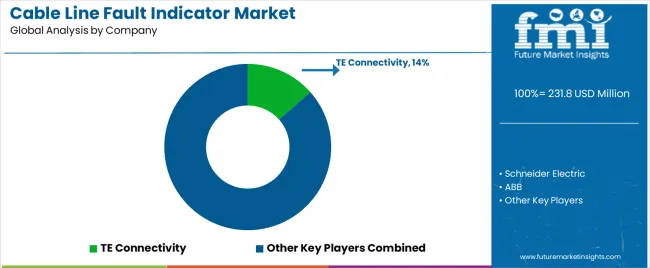
The cable line fault indicator market operates with moderate concentration, featuring approximately 15-20 participants, where leading companies control roughly 38-44% of the global market share through established distribution networks and comprehensive technology portfolio capabilities. Competition emphasizes monitoring reliability, communication performance, and integration efficiency rather than premium feature rivalry.
Market leaders encompass TE Connectivity, Schneider Electric, and ABB, which maintain competitive advantages through extensive power electronics expertise, global distribution networks, and comprehensive technical support capabilities that create utility loyalty and support industrial requirements. These companies leverage decades of electrical equipment experience and ongoing technology investments to develop advanced fault indicator systems with exceptional reliability and communication features.
Specialty challengers include Eaton, siemens, and Elektro-Mechanik, which compete through specialized application innovation focus and efficient technology solutions that appeal to utility buyers seeking reliable performance formats and custom integration flexibility. These companies differentiate through operational efficiency emphasis and specialized market focus.
Market dynamics favor participants that combine consistent monitoring performance with advanced communication support, including IoT connectivity and data analytics capabilities. Competitive pressure intensifies as traditional electrical equipment manufacturers expand into fault indicator systems. At the same time, specialized monitoring solution providers challenge established players through innovative communication protocols and cost-effective production targeting emerging utility segments.
| Item | Value |
|---|---|
| Quantitative Units | USD 231.8 million |
| Type | Automatic Reset, Manual Reset, Others |
| Application | Commercial, Residential, Industrial, Utility, Transportation, Others |
| Technology | Overhead Line Indicators, Underground Cable Indicators, Panel Mount Indicators, Portable Testing Units |
| Regions Covered | Asia Pacific, North America, Europe, Latin America, Middle East & Africa |
| Countries Covered | China, India, Germany, Brazil, U.S., U.K., Japan, and 25+ additional countries |
| Key Companies Profiled | TE Connectivity, Schneider Electric, ABB, Eaton, siemens, Elektro-Mechanik |
| Additional Attributes | Dollar sales by type and application categories, regional adoption trends across Asia Pacific, North America, and Europe, competitive landscape with power electronics manufacturers and monitoring solution providers, utility preferences for communication capabilities and diagnostic performance, integration with grid management systems and automation platforms, innovations in IoT connectivity and wireless communication technology, and development of specialized monitoring solutions with enhanced reliability features and predictive analytics capabilities |
The global cable line fault indicator market is estimated to be valued at USD 231.8 million in 2025.
The market size for the cable line fault indicator market is projected to reach USD 314.6 million by 2035.
The cable line fault indicator market is expected to grow at a 3.1% CAGR between 2025 and 2035.
The key product types in cable line fault indicator market are automatic reset , manual reset and others.
In terms of application, commercial segment to command 65.0% share in the cable line fault indicator market in 2025.






Our Research Products

The "Full Research Suite" delivers actionable market intel, deep dives on markets or technologies, so clients act faster, cut risk, and unlock growth.

The Leaderboard benchmarks and ranks top vendors, classifying them as Established Leaders, Leading Challengers, or Disruptors & Challengers.

Locates where complements amplify value and substitutes erode it, forecasting net impact by horizon

We deliver granular, decision-grade intel: market sizing, 5-year forecasts, pricing, adoption, usage, revenue, and operational KPIs—plus competitor tracking, regulation, and value chains—across 60 countries broadly.

Spot the shifts before they hit your P&L. We track inflection points, adoption curves, pricing moves, and ecosystem plays to show where demand is heading, why it is changing, and what to do next across high-growth markets and disruptive tech

Real-time reads of user behavior. We track shifting priorities, perceptions of today’s and next-gen services, and provider experience, then pace how fast tech moves from trial to adoption, blending buyer, consumer, and channel inputs with social signals (#WhySwitch, #UX).

Partner with our analyst team to build a custom report designed around your business priorities. From analysing market trends to assessing competitors or crafting bespoke datasets, we tailor insights to your needs.
Supplier Intelligence
Discovery & Profiling
Capacity & Footprint
Performance & Risk
Compliance & Governance
Commercial Readiness
Who Supplies Whom
Scorecards & Shortlists
Playbooks & Docs
Category Intelligence
Definition & Scope
Demand & Use Cases
Cost Drivers
Market Structure
Supply Chain Map
Trade & Policy
Operating Norms
Deliverables
Buyer Intelligence
Account Basics
Spend & Scope
Procurement Model
Vendor Requirements
Terms & Policies
Entry Strategy
Pain Points & Triggers
Outputs
Pricing Analysis
Benchmarks
Trends
Should-Cost
Indexation
Landed Cost
Commercial Terms
Deliverables
Brand Analysis
Positioning & Value Prop
Share & Presence
Customer Evidence
Go-to-Market
Digital & Reputation
Compliance & Trust
KPIs & Gaps
Outputs
Full Research Suite comprises of:
Market outlook & trends analysis
Interviews & case studies
Strategic recommendations
Vendor profiles & capabilities analysis
5-year forecasts
8 regions and 60+ country-level data splits
Market segment data splits
12 months of continuous data updates
DELIVERED AS:
PDF EXCEL ONLINE
Cable Fault Locator Market Size, Share, and Forecast 2025 to 2035
Lined Dip Pipes Market Size and Share Forecast Outlook 2025 to 2035
Linear Regulator ICs (LDOs) Market Forecast and Outlook 2025 to 2035
Line Post Porcelain Insulator Market Size and Share Forecast Outlook 2025 to 2035
Cable Tray Market Size and Share Forecast Outlook 2025 to 2035
Linerless Label Market Size and Share Forecast Outlook 2025 to 2035
Cable Granulator Market Size and Share Forecast Outlook 2025 to 2035
Cable Distribution Cabinets Market Size and Share Forecast Outlook 2025 to 2035
Fault Detection and Classification Market Size and Share Forecast Outlook 2025 to 2035
Linear Alkylbenzene Sulfonate (LAS) Market Size and Share Forecast Outlook 2025 to 2035
Linear Low-Density Polyethylene Market Size and Share Forecast Outlook 2025 to 2035
Linear Low Density Polyethylene Market Size and Share Forecast Outlook 2025 to 2035
Line Printer Market Size and Share Forecast Outlook 2025 to 2035
Linear Slide Units Market Size and Share Forecast Outlook 2025 to 2035
Linear Residential Voltage Regulator Market Size and Share Forecast Outlook 2025 to 2035
Cable Accessories Market Growth - Trends & Forecast 2025 to 2035
Linear Net Weighing Machines Market Size and Share Forecast Outlook 2025 to 2035
Cable Cleaning Solutions Market Analysis - Size, Share, and Forecast Outlook 2025 to 2035
Cable Cleaning Equipment Market Analysis - Size, Share, and Forecast Outlook 2025 to 2035
Linerless Closures Market Size and Share Forecast Outlook 2025 to 2035

Thank you!
You will receive an email from our Business Development Manager. Please be sure to check your SPAM/JUNK folder too.
Chat With
MaRIA